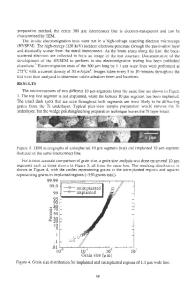Electromigration of Electroplated Gold Interconnects
- PDF / 318,525 Bytes
- 6 Pages / 612 x 792 pts (letter) Page_size
- 1 Downloads / 430 Views
B8.30.1
Electromigration of Electroplated Gold Interconnects Steve Kilgore, *Craig Gaw, *Haldane Henry, *Darrell Hill, and †Dieter Schroder Intrinsic Reliability Engineering Laboratory, Freescale Semiconductor, Inc. Tempe, AZ 85284, U.S.A. * Microwave & Mixed-Signal Technologies Laboratory, Freescale Semiconductor, Inc. Tempe, AZ 85284, U.S.A. † Department of Electrical Engineering, Arizona State University Tempe, AZ 85287, U.S.A. ABSTRACT Electromigration tests were performed on passivated electroplated Au four terminal Kelvin line structures using the conventional in situ resistance monitoring technique. The stress conditions were a current density of 2.0 MA/cm2 with ambient temperatures ranging from 325°C to 375°C. The temperature coefficients of resistance (TCR) values were measured prior to current stressing to calculate the Joule heated film temperatures. The times to failure (lifetimes) for the Au line structures were considered as a 50% ∆R/R0 change. The median time to failure (t50%) was plotted against the inverse film temperature to determine the activation energy value as 0.59 ± 0.09 eV. Failure analysis of void location and suggested diffusion mechanism will be discussed. INTRODUCTION Electromigration (EM) of metal interconnects has been well understood to cause semiconductor integrated circuit failures. Most of the earlier EM studies were focused mainly on aluminum interconnects in silicon based semiconductors [1-7]. Development of Radio Frequency (RF) high power devices on GaAs substrates having higher current density and junction (metal) temperatures requires improved reliability. Therefore, other metallizations were examined for uses as interconnects in order to find better comparability with GaAs (ohmic contacts) and to improve electromigration reliability. These GaAs devices converted to gold metallization in the early 1970’s since it produces a better ohmic contact with better electrical and thermal conductivity properties and believed to have improved resistance to electromigration due to its higher melting point. Gold interconnects and bond pads also have a packaging advantage since the problems associated with AuAl2 intermetallic formation that occurs when aluminum bond wires are connected to gold at elevated temperatures. Now gold-based metal systems are widely used for interconnects on GaAs based electronics such as metal semiconductor field effect transistors (MESFETs) and heterojunction bipolar transistors (HBTs) for high power applications. Thus, the understanding of the electromigration mechanisms of Au films is of significant importance to high power GaAs applications. The study of electromigration has evolved from fundamental diffusion studies using visual techniques on limited samples [8] to statistically rigorous resistometric lifetime experiments involving evolution of void growth mechanisms [9]. The primary focus of EM experiments in industry today is predicting interconnect lifetimes under field operating conditions. The trend in the semiconductor industry has moved towards reduce
Data Loading...











